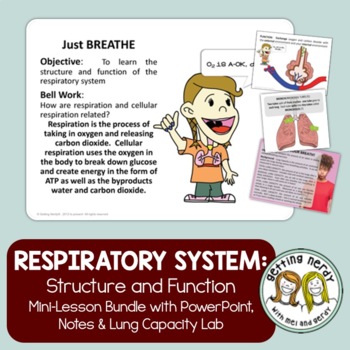- Zip
- Google Apps™

Description
O2 is A-OK in our book... at least that's what you'll learn during our respiratory system presentation, notes and lab.
WHAT'S INCLUDED in this 1-2 DAY LESSON:
• EDITABLE Animated PowerPoint with daily objective, bellwork, student notes and lab instructions
• NON-EDITABLE PDF notes pages and lab pages
• DIGITAL GOOGLE CLASSROOM links to all items listed above which can be easily converted to Microsoft School with directions provided or altered to fit your school’s personal learning management system
STUDENTS WILL:
• Take notes covering the structure and function of the human respiratory system using the animated PowerPoint
• Learn about the structure and function of the organs of the Respiratory system: pharynx, larynx, bronchi, bronchioles, lungs, alveoli, and diaphragm
• Make the connection between the need for oxygen and Cellular Respiration within cells
• Use the “Don’t Hold Your Breath” lab to determine lung capacity using balloons and rulers
THIS PRODUCT IS ALSO FOUND IN OUR:
LIFE SCIENCE CURRICULUM BUNDLE
SEE HOW THIS LESSON ALIGNS WITH THE NGSS, TEKS or GSE
Because we have created many of our own graphics or have purchased licenses to other graphics with permission, we cannot offer our resources in editable format unless otherwise stated.
TERMS OF USE (TOU):
All rights reserved by GETTING NERDY®️.
• This product is to be used by the original purchaser only
• Intended for classroom and personal use only
• Copying for more than one teacher, classroom, department, school, or school system is prohibited.
• This product may not be distributed or displayed digitally for public view
Failure to comply is a copyright infringement and a violation of the Digital Millennium Copyright Act (DMCA). Clipart and elements found in this PDF are copyrighted and cannot be extracted and used outside of this file without permission or license.
Respiratory System and Lung Capacity Lab © 2012 to present GETTING NERDY®️ All Rights Reserved
www.gettingnerdyscience.com
Total Pages: 9 Powerpoint Slides and 3 pages of handouts
File Size: 2 MB





